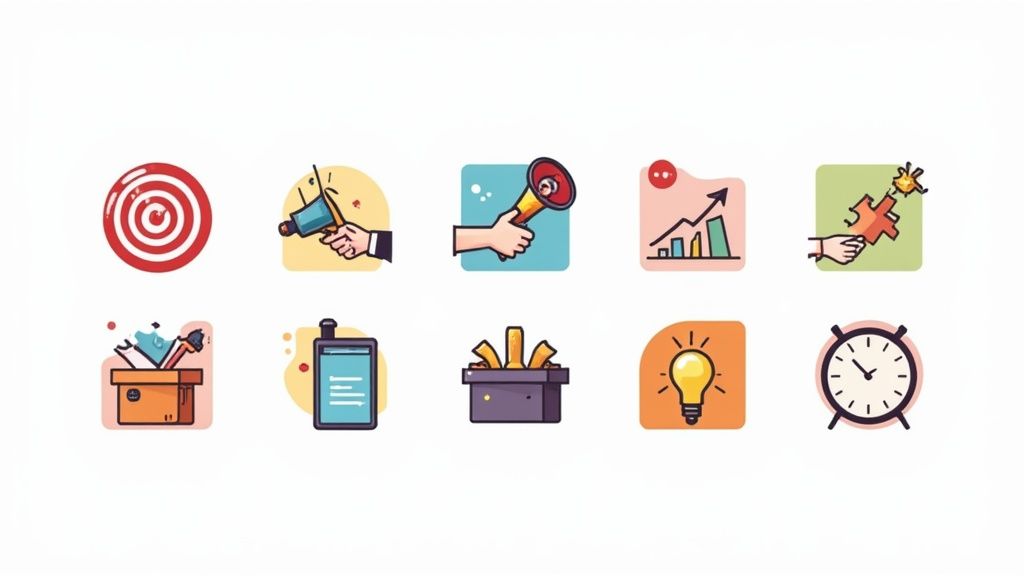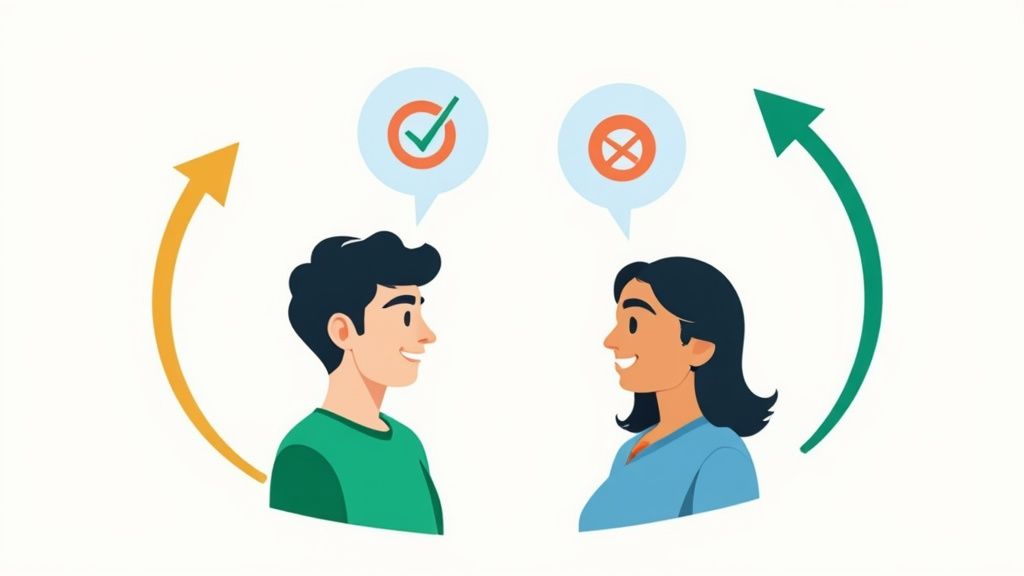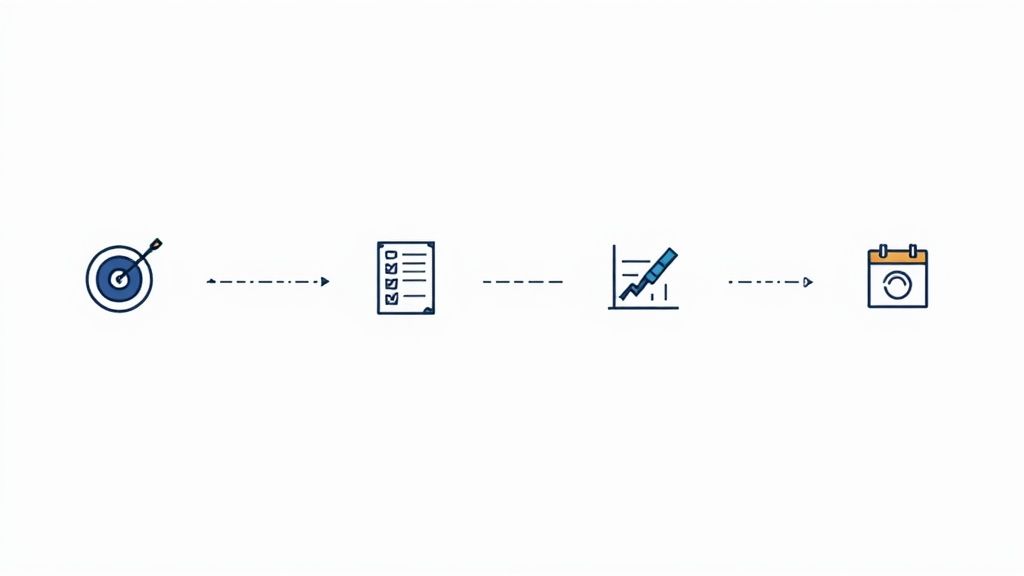
Let's be real. Most performance management systems are a special kind of corporate hell. They’re a bureaucratic mess of annual reviews, forced rankings, and awkward conversations that everyone, from intern to CEO, dreads. It’s a system designed for a different era, one that feels completely out of touch with how modern, remote, and distributed teams actually work. If you’re still relying on a once-a-year sit-down to gauge performance, you're not just behind the curve; you're actively disengaging your best people. The old way is slow, subjective, and frankly, a waste of everyone’s time.
This isn’t another fluffy article rehashing the same old advice. We’re getting straight to the point with battle-tested strategies that actually move the needle. You're here for actionable performance management best practices you can implement without mortgaging your office ping-pong table. We're going to break down nine specific, high-impact methods, from setting crystal-clear OKRs to building a culture of continuous feedback that doesn't feel like a trip to the principal's office. Think of this as your playbook for turning performance management from a necessary evil into your company’s secret weapon. No theory, just what works.
Ditching the dreaded annual review isn't just a trendy idea; it’s one of the most effective performance management best practices you can implement. The Continuous Feedback Model swaps that once-a-year, high-stakes meeting for a culture of ongoing, real-time dialogue. Think less formal judgment, more in-the-moment coaching. It's about correcting course with a gentle nudge today, not dropping a bombshell report six months from now when it's too late to fix anything.

We've all seen this work. Tech giants like Adobe famously torched their traditional reviews for a “Check-In” system, forcing regular conversations between managers and employees. Microsoft shifted its entire culture under Satya Nadella to prioritize ongoing coaching, moving away from a soul-crushing system that pitted employees against each other. The goal is simple: make feedback a normal, expected part of the workflow, not a scary, isolated event.
Getting this right means moving beyond just saying "let's talk more." You need a spine for the system.
If you’ve ever set a lofty company goal only to watch it get swallowed by the daily grind, OKRs are your new best friend. This isn't just another corporate acronym; it’s a framework for getting everyone, from the CEO to the intern, pulling in the same direction. The system pairs an ambitious, qualitative Objective (Where are we going?) with a few specific, measurable Key Results (How do we know we’re not just kidding ourselves?).

It’s the system that took Google from a scrappy startup to a global titan, a practice they famously ripped off from Intel. But it’s not just for tech giants. Companies like LinkedIn and Spotify use OKRs to drive everything from product development to market expansion. The magic is in the alignment; it forces clarity and focuses effort on what truly matters, making it one of the most powerful performance management best practices for teams that want to win.
Rolling out OKRs isn't just about filling out a new spreadsheet. It’s about rewiring how your team thinks about goals.
If you really want to know how someone is performing, asking their boss is only part of the story. The 360-Degree Feedback model is one of the most powerful performance management best practices because it widens the lens. Instead of a single top-down view, it pulls in anonymous, structured feedback from peers, direct reports, and even external stakeholders. It’s like switching from a single security camera to a full-blown CCTV system; you suddenly see everything, not just the angle you were expecting.

This isn’t just some fluffy HR trend. Global giants like Johnson & Johnson and PwC have long used this multi-source approach in their leadership development programs to identify blind spots and build well-rounded managers. The goal is to provide a holistic view that a single manager simply cannot see, revealing how an individual’s actions truly impact the entire team. It moves performance from a private conversation to a community-informed insight.
Rolling this out without a plan is a recipe for hurt feelings and office drama. You need to be deliberate.
If you’re setting goals that sound like “do better next quarter,” you might as well just wish on a star. The SMART Goals Framework is the antidote to vague, uninspired objectives. It forces clarity by ensuring every goal is Specific, Measurable, Achievable, Relevant, and Time-bound. This isn't bureaucratic fluff; it's a proven method for turning fuzzy ambitions into concrete action plans. Think of it as the difference between hoping for sales growth and actually having a plan to get it.

This framework is a classic for a reason: it works. Sales teams use it to set revenue targets like "Increase Q3 sales of Product X by 15%." A marketing team might aim to "Achieve a 5% conversion rate on the new landing page within 60 days." The magic is in the details. By defining precisely what success looks like and when it should happen, you eliminate guesswork for everyone, making it one of the most reliable performance management best practices out there.
Setting a goal is easy; setting a smart one takes discipline. Here’s how to drill this into your culture.
Here's a radical idea: stop being a boss and start being a coach. A coaching and mentoring culture is one of the most powerful performance management best practices because it shifts the focus from judging past performance to building future capability. It's about seeing your employees not just as cogs in a machine, but as professionals with potential you're supposed to unlock.
This isn't some feel-good corporate fluff. Google's "Project Oxygen" research proved that the single most important behavior of its best managers was being a good coach. (Toot, toot! We’re not saying we’re perfect, just that Google agrees with us.) Similarly, Salesforce's "Ohana Culture" integrates mentoring to ensure no one is left to figure things out alone. The goal is to build an environment where learning and guidance are woven into the daily fabric of work, not reserved for a crisis.
You can’t just tell managers to "be better coaches" and expect a miracle. You have to build the machine for it.
It's time to stop managing by gut feeling. This means treating performance not as an abstract art, but as a science. Performance analytics is about using hard data to understand what's actually driving success in your organization, turning vague hunches into actionable, evidence-based strategies. You stop guessing who your top performers are and start knowing why they are.
This isn't some far-off corporate fantasy. Google’s Project Oxygen used analytics to pinpoint the specific behaviors of its most effective managers, then trained all managers on those traits. IBM’s workforce science team developed models to predict employee attrition and performance, letting them intervene before talent walked out the door. The goal is to swap opinions for objective insights and make smarter decisions about coaching, development, and who gets the good projects.
Diving into data can feel overwhelming, but a structured approach makes it manageable. You don't need a team of data scientists to start.
Waiting for the boss to hand out praise is an old, slow, and broken model. One of the most impactful performance management best practices is empowering the people who see the great work every day: your team. Peer-to-peer recognition programs turn everyday appreciation into a structured, visible, and powerful part of your culture. This isn't about gold stars; it’s about democratizing recognition and catching those small, brilliant moments managers always miss.
This approach dismantles the top-down bottleneck of appreciation. Salesforce uses a recognition platform for peer nominations, tying shout-outs directly to company values. Adobe’s "Bravo!" program lets any employee award a small bonus to a deserving colleague, making recognition tangible and immediate. The goal is to create a culture where celebrating each other's wins is a daily habit, not a rare event. When your team feels seen by their peers, engagement and collaboration go through the roof.
A free-for-all praise channel can quickly become noise. You need a framework to make it meaningful.
Beyond simple performance metrics, Individual Development Plans (IDPs) are one of the most powerful performance management best practices for keeping your best people from walking out the door. An IDP is a structured roadmap for an employee's professional growth, co-created by the employee and their manager. Think of it as a personalized career GPS that aligns an individual’s ambitions with the company's future needs. It answers the question, "What's next for me here?" before your best people start asking it on LinkedIn.
This isn’t just a nice-to-have. Companies like General Electric and Accenture built their leadership pipelines on this very concept, using structured development planning to cultivate talent from within. An IDP turns the abstract idea of "growth" into a concrete action plan, showing employees you're invested in their entire career, not just their output this quarter. It’s the difference between managing tasks and developing talent.
A great IDP is more than a checklist of training courses. It’s a strategic partnership.
If continuous feedback is the philosophy, then regular one-on-ones are where the real work gets done. These scheduled check-ins are the dedicated time that turns good intentions into tangible results. Think of them less as mini-reviews and more as tactical huddles focused on progress, roadblocks, and growth. It’s where managers stop managing tasks and start developing people.
This isn't just about asking "what are you working on?" It's a practice championed by management legends from Andy Grove to Ben Horowitz. Google trains its managers to make one-on-ones employee-driven, focusing on career development and problem-solving. At Netflix, these sessions are critical for providing the candid feedback its high-performance culture demands. They are the absolute backbone of modern performance management best practices.
A bad one-on-one is just another meeting that could have been an email. A great one is the most valuable 30 minutes of an employee's week.
| Item | Implementation Complexity | Resource Requirements | Expected Outcomes | Ideal Use Cases | Key Advantages |
|---|---|---|---|---|---|
| Continuous Feedback Model | Moderate to High (requires manager training, consistent application) | Significant time investment from managers, digital platforms | Improved engagement, faster problem resolution, stronger relationships | Ongoing performance improvement, agile teams | Real-time feedback, builds manager-employee trust |
| OKRs (Objectives and Key Results) | Moderate (needs cultural shift and training) | Time for goal setting, tracking tools | Enhanced alignment, transparency, ambition | Organizational goal alignment and prioritization | Promotes focus, transparency, and innovation |
| 360-Degree Feedback | High (complex multi-source collection and analysis) | Time-intensive, often expensive | Holistic performance insights, self-awareness | Leadership development, high-potential assessments | Comprehensive feedback reducing bias |
| SMART Goals Framework | Low to Moderate (simple methodology but requires discipline) | Time for goal formulation and review | Clear, measurable, achievable objectives | Individual and team goal setting | Clarity, accountability, and measurable targets |
| Coaching and Mentoring Culture | High (requires extensive manager training and cultural change) | Significant training and ongoing support | Enhanced leadership, continuous learning | Leadership development, capability building | Builds confidence and internal talent mobility |
| Performance Analytics and Data-Driven Insights | High (requires technology infrastructure and expertise) | Investment in analytics tech and training | Objective performance insights, predictive capabilities | Strategic workforce planning and talent decisions | Removes bias, enables data-driven decisions |
| Peer-to-Peer Recognition Programs | Low to Moderate (platform setup and cultural adoption needed) | Investment in recognition platforms | Increased engagement, morale, and collaboration | Employee motivation and culture reinforcement | Frequent, visible recognition, strengthens peer bonds |
| Individual Development Plans (IDPs) | Moderate to High (requires manager involvement and process) | Time for planning, skills assessment | Structured career growth and skill development | Career planning and succession management | Clear development pathways, improved retention |
| Regular Performance Check-ins and One-on-Ones | Moderate (requires scheduling and manager skill) | Time investment for recurring meetings | Stronger relationships, faster issue resolution | Continuous performance management | Builds trust, supports development, timely feedback |
So, there you have it. A deep dive into the performance management best practices that actually move the needle, minus the corporate jargon and soul-crushing bureaucracy. We’ve walked through everything from the relentless cadence of continuous feedback to the laser focus of OKRs, from the humbling honesty of 360-degree reviews to the simple, human power of a well-run one-on-one.
If you’re feeling a bit overwhelmed, take a breath. You don’t need to boil the ocean and implement all nine of these strategies by next Tuesday. That’s a recipe for chaos and a team that’s more focused on tracking metrics than doing meaningful work. The real takeaway here isn't a rigid checklist; it's a fundamental shift in mindset.
Let’s be honest, traditional performance management felt like a system designed by people who’ve never actually managed anyone. It was a top-down, once-a-year judgment day. The performance management best practices we've covered aren't just about tweaking that old system; they're about demolishing it and building something better in its place.
The new goal isn't to manage performance. It's to create an environment where high performance is the natural outcome. It’s about building a culture where:
Feeling inspired? Good. Now, turn that inspiration into action. Don’t just bookmark this article and let it gather digital dust. Pick one thing. Just one.
Is your team starved for positive reinforcement? Start with a peer-to-peer recognition program. It’s low-cost, high-impact, and can be set up in an afternoon. Are your one-on-ones feeling stale and repetitive? Commit to structuring them around Individual Development Plans (IDPs) to make them forward-looking and career-focused. Are you flying blind on team progress? Implement a simple OKR framework for one department and see what happens.
Mastering these concepts is about more than just boosting productivity or retention numbers. It's about building a resilient, adaptable organization where people feel valued, see a path for growth, and are genuinely motivated to do their best work. It’s about building a company people are proud to work for. Now, go build it.
